‘The fight continues’: Colombia protests persist despite pandemic
Anti-government protest organisers say the movement continues to evolve amid the coronavirus outbreak.
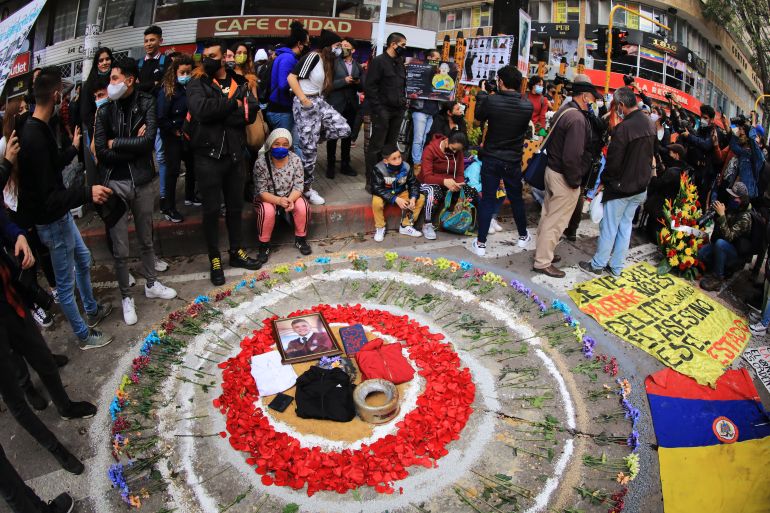
Bogota, Colombia – Hundreds of people gathered at a street corner in downtown Bogota on Monday to commemorate the anniversary of Dilan Cruz’s death. His mother and sister arranged a circle of flowers on the street where the 18-year-old was shot by police a year earlier during an anti-government protest, with his clothes and a framed portrait placed in the centre.
Throughout the vigil, the mostly young crowd chanted: “Dilan didn’t die, Dilan was killed!”
Keep reading
list of 4 itemsInmates killed in Colombia riot shot intentionally: HRW
Bojaya: Colombia’s community leaders caught in the crossfire
Colombia raises deficit target due to pandemic: COVID-19 news
The killing of Cruz, who was shot with a projectile by riot police at close range, fuelled Colombia’s burgeoning anti-government protests in late 2019. What began in November as a “National Strike” against labour reforms, quickly evolved into a nationwide anti-government movement.
Hundreds of thousands of Colombians rallied to express their anger with the administration of President Ivan Duque over a range of issues, including its implementation of the 2016 peace deal, economic reforms, inattention to rural populations, inequality and the assassination of social leaders.
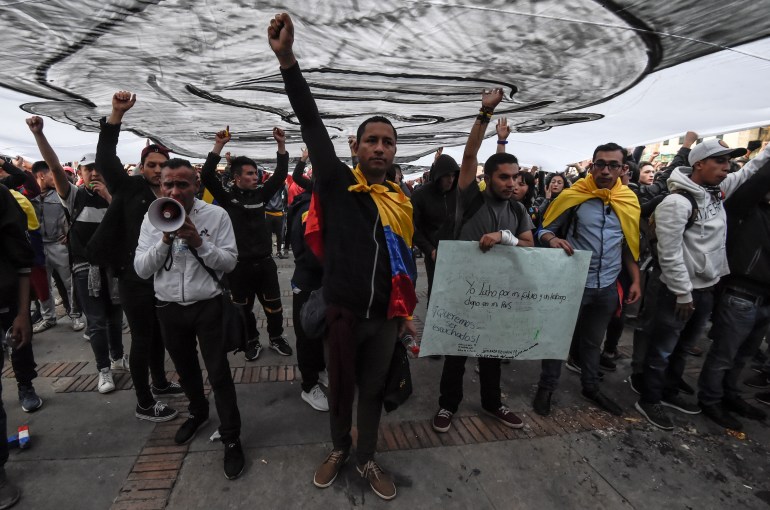
The protest movement lost momentum earlier this year amid the country’s coronavirus outbreak, with Duque in March introducing wide-ranging restrictions in an attempt to minimise the virus’s spread. Much of the country remained under lockdown for six months as the government banned mass gatherings.
Colombia has confirmed more than 1.25 million cases of COVID-19 and its death toll from the disease has passed 35,000, according to a Johns Hopkins University tally. Its economy has also deteriorated amid the restrictions, with some sectors only re-opening in September. Informal workers, who make up roughly 47 percent of Colombia’s workforce, have been the hardest hit and are also the most vulnerable to COVID-19.
Despite the months-long restrictions, the movement has continued activities. In June, the National Strike Committee sent a letter to President Duque outlining six suggested measures to respond to the dual health and economic crises, including emergency rent subsidies and increased support for the public education system. Duque’s administration had not responded to the letter or met the committee at the time of publication.
“This year, despite the pandemic, I’ve seen many youths and families with a lot of social consciousness,” said Laura Garzon, one of Dilan Cruz’s teachers who attended the vigil.
“The future is uncertain, but regardless the fight continues.”
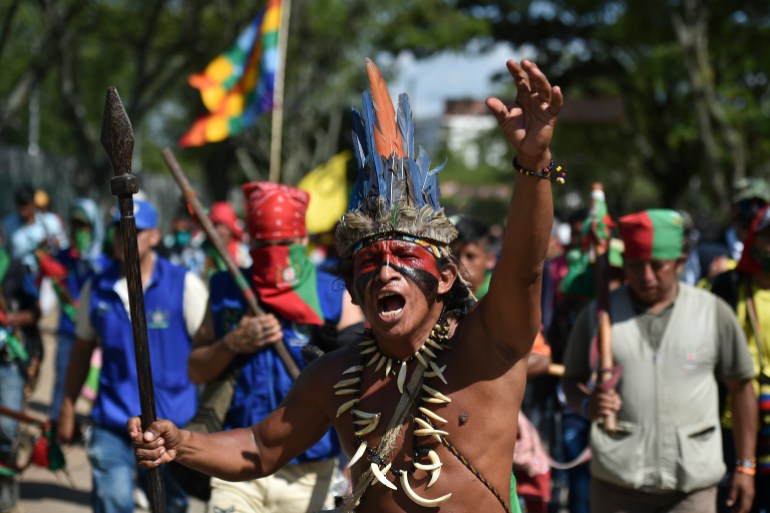
The committee and other collectives have also organised a handful of marches in recent months to demand emergency measures to provide financial relief and healthcare guarantees.
Ruben Pinilla, a teacher and organiser for the District Association of Education Workers, said that thousands of protesters had taken part in several demonstrations since June, despite the restrictions. Among them was the Indigenous Minga gathering from October 17 to 21, when 8,000 Indigenous people from the southwest of Colombia travelled hundreds of miles to the capital to demand governmental reform and protection for their territories and their leaders.
In a recent instalment of the national strike, thousands of students and workers took part in marches on November 19 demanding government reforms. The Central Union of Workers marched with banners declaring that “Duque neither listens nor negotiates.”
“We are young people representing a voice that is trying and seeking to transform our futures,” said Fabio Castro, director of activist drumming group Barbukana. He told Al Jazeera he marched in hope that the government would distribute resources equitably. “Art is one of the most forgotten sectors during this pandemic – there’s no economic relief, and the government doesn’t offer us employment opportunities either,” he said.
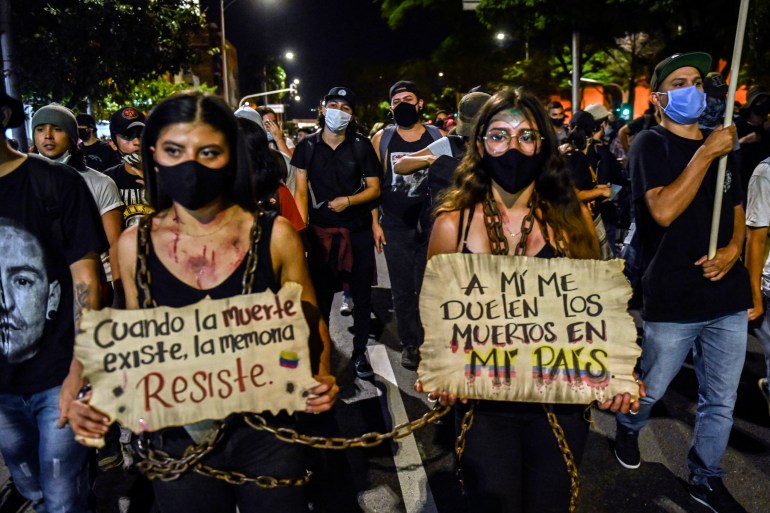
While the government has provided some emergency relief, authorities have opened several investigations into irregularities in contracts linked to emergency coronavirus aid and the potential involvement of officials.
Gimena Sanchez-Garzoli, director of the advocacy group Andes for the Washington Office on Latin America, told Al Jazeera, “In addition to the previous discontent, now protesters are reacting to the mass corruption of COVID-19 funds.” She added that some politicians have wielded the pandemic as an excuse to ignore pleas for increased security and other reforms.
The government has blamed recent protests on “outside infiltrators” from the ELN armed group and remaining FARC dissidents. During the heated and spontaneous protests against police brutality in September, the defence ministry pronounced them “an articulated, systemic, organised manifestation of violence and vandalism”.
When the committee announced plans for a march on November 21, the anniversary of the biggest mass mobilisation during last year’s protests, the government announced that select purchases would be tax-free on that day. The protests were a fraction of the size of the previous year’s event, and local media reported floods of consumers in shopping centres.
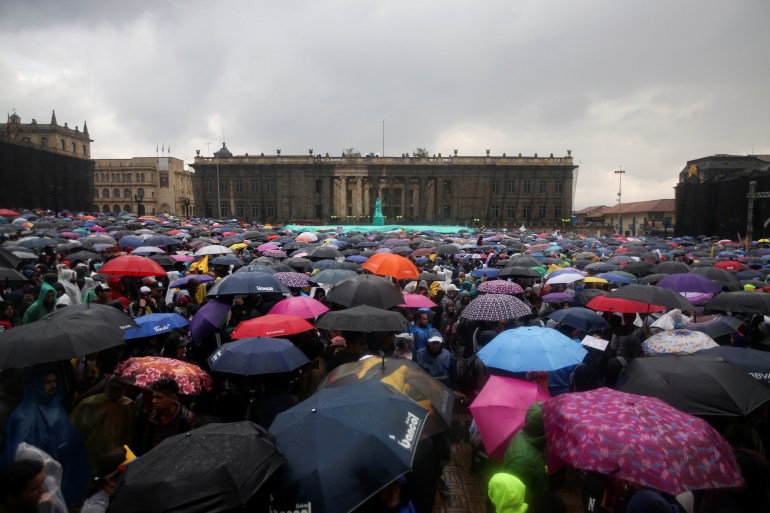
Pinilla told Al Jazeera that organisers did not see the “critical mass” they were hoping to welcome in the capital’s main plaza, but that it was important to recognise that people gathered in their respective neighbourhoods throughout Colombia.
“In this moment, it is important to strengthen the permanent presence [of the movement] in each territory,” he added.
While the COVID-19 outbreak could continue to deter some people from taking part in mass gatherings, protest organisers and analysts said the movement could continue to evolve on local levels.
Shauna Gillooly, PhD candidate and researcher in political science at UC Irvine, said that the national strike committee should ally with those protesting police brutality to amplify the movement in the future. In September, when a man was killed after police repeatedly shocked him with a taser in Bogota, the city exploded into protests.
“There need to be conversations about the national strike expanding demands and turning to the factions within the national strike who weren’t represented well last year,” she said.
Pinilla’s organisation has been negotiating with local administrations, calling for more political involvement and voter participation in the next congressional election, and is hopeful social movements will continue to grow.
“It’s an evolution not in size or quantity, but in profound conviction and understanding of the causes that build this platform for peaceful change,” Pinilla told Al Jazeera.